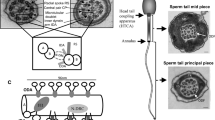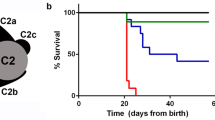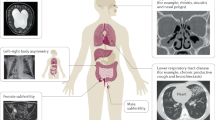Summary
In mice homozygous for the mutation hydrocephalic-polydactyl (hpy) ciliary axonemes from tracheal, oviducal, and ependymal lining cells showed a variety of abnormalities. Defects included: a deficiency of inner dynein arms, extra central tubules, a displacement of one outer doublet and/or the central tubules, and double axonemes. More than one kind of defect was seen in some axonemes. None of the types of defects observed in mutants were encountered in equivalent samples from non-mutant littermates. Except for the most common defect, the deficiency in dynein arms, which occured to about the same extent (approximately 34%) in all three tissues, there were marked variations in frequency among the tissue types with respect to the other defects. In general, defects such as central tubule anomalies, displaced tubules, and double axonemes occured with the highest frequencies in axonemes from tracheal epithelial cells and with the lowest frequencies in samples of oviducal epithelium. Fused cilia were seen only in ependymal cell samples. Some of the defects encountered were common to sperm flagella axonemes while others appeared restricted to somatic tissues, suggesting, perhaps, each tissue type may exert its own modulating influence on the expression of the mutant gene.
Similar content being viewed by others
References
Afzelius BA, Camner P, Mossberg B (1978) On the function of cilia in the female reproductive tract. Fertil Steril 29:72–74
Baccetti B, Burrini AG, Maver A, Pallini V, Renieri T (1979a) “9+0” immotile spermatozoa in an infertile man. Andrologia 11:437–443
Baccetti B, Burrini AG, Pallini V, Renieri T (1979b) Human dynein polypeptides in Kartagener's and “9+0” spermatozoa. J Cell Biol 83:183a
Bryan JHD (1977) Spermatogenesis revisited. IV. Abnormal spermiogenesis in mice homozygous for another male-sterility-inducing mutationhpy (hydrocephalic-polydactyl). Cell Tissue Res 180:187–201
Bryan JHD (1981) Spermatogenesis revisited. V. Spermiogenesis in mice homozygous for two different male-sterile mutations (p s andhpy). Cell Tissue Res 221:169–180
Bryan JHD (1983) The immotile cilia syndrome: Mice versus men. Virchows Arch [Pathol Anat] 399:265–275
Bryan JHD, Chandler DB (1978) Tracheal ciliary defects in mice homozygous for a recessive pleiotropic mutation hydrocephalic-polydactyl. J Cell Biol 79:281a
Bryan JHD, Wolosewick JJ (1973) Spermatogenesis revisited. II. Ultrastructural studies of spermiogenesis in multinucleate spermatids of the mouse. Z Zellforsch 138:155–169
Dahl HA (1963) Fine structure of cilia in rat cerebral cortez. Z Zellforsch 60:369–386
Dalen H (1981) An ultrastructural study of primary cilia and ciliary knobs from the ciliated cells of the guinea-pig trachea. Cell Tissue Res 220:685–697
Denoulet P, Jeantet C, Gros F (1982) Tubulin microheterogeneity during mouse liver development. Biochem Biophys Res Comms 105:806–813
Flood PR, Totland GK (1977) Substructure of solitary cilia in mouse kidney. Cell Tissue Res 183:281–290
Gozes I, Barnstable CJ (1982) Monoclonal antibodies that recognize discrete forms of tubulin. Proc Natn Acad Sci USA 79:2579–2583
Hollander WF (1976) Hydrocephalic-polydactyl, a recessive pleiotropic mutation in the mouse and its location in chromosome 6. Iowa State J Res 51:13–23
Kemphues KJ, Raff EC, Raff RA, Kaufman TC (1980) Mutation in a testis-specific-tubulin in Drosophilia: Analysis of its effect on meiosis and map location of the gene. Cell 21:445–451
Kuhn C, Engleman W (1978) The structure of the tips of mammalian respiratory cilia. Cell Tissue Res 186:491–498
Sorokin SP (1968) Reconstructions of centriole formation and cioliogenesis in mammalian lungs. J Cell Sci 3:207–230
Sturgess JM, Chao J, Wong J, Aspin N, Turner JAP (1979) Cilia with defective radial spokes — a cause of human respiratory disease. N Engl J Med 300:53–56
Sturgess JM, Chao J, Turner JAP (1980) Transposition of ciliary microtubules: Another cause of impaired ciliary motility. N Engl J Med 303:318–322
Author information
Authors and Affiliations
Additional information
The author wishes to express his thanks to Mr. David B. Chandler and Mr. Clifford S. Shuman III for capable technical assistance
Rights and permissions
About this article
Cite this article
Bryan, J.H.D. Abnormal cilia in a male-sterile mutant mouse. Vichows Archiv A Pathol Anat 400, 77–86 (1983). https://doi.org/10.1007/BF00627011
Accepted:
Issue Date:
DOI: https://doi.org/10.1007/BF00627011




